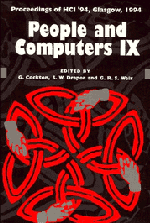Book contents
- Frontmatter
- Contents
- Preface: HCI'94 – You Probably Haven't Seen It All Before
- Part I Invited Papers
- 1 The Future of Graphic User Interfaces: Personal Role Managers
- 2 Beyond the Workstation: Mediaspaces and Augmented Reality
- Part II Methodology of Interactive Systems Development
- Crafting Interaction: Styles, Metaphors, Modalities and Agents
- Modelling Humans, Computers and their Interaction
- Notations and Tools for Design
- Part VI Computer-Supported Cooperative Work
- Author Index
- Keyword Index
2 - Beyond the Workstation: Mediaspaces and Augmented Reality
Published online by Cambridge University Press: 04 August 2010
- Frontmatter
- Contents
- Preface: HCI'94 – You Probably Haven't Seen It All Before
- Part I Invited Papers
- 1 The Future of Graphic User Interfaces: Personal Role Managers
- 2 Beyond the Workstation: Mediaspaces and Augmented Reality
- Part II Methodology of Interactive Systems Development
- Crafting Interaction: Styles, Metaphors, Modalities and Agents
- Modelling Humans, Computers and their Interaction
- Notations and Tools for Design
- Part VI Computer-Supported Cooperative Work
- Author Index
- Keyword Index
Summary
The embodiment of computers in desktop workstations has had a tremendous impact on the field of HCI. Now that mice and graphics displays are everywhere, the workstation defines the frontier between the computer world and the real world. We spend a lot of time and energy transferring information between those two worlds. This could be reduced by better integrating the real world with the computer world. This article describes two approaches to this integration: Mediaspaces, which allow people to communicate through an audio, video and computer environment, and Augmented Reality, which adds computational power to real world objects. The argument is made that the success of these approaches lies in their ability to build on fundamental human skills, namely the ability to communicate with other people and the ability to interact with objects in the real world.
Keywords: mediaspace, augmented reality, multimedia, video, virtual reality, paper interface, gesture input, metaphor, paradigm.
Introduction
Over the last decade, computers have evolved from mainframes to networks of personal computers and workstations. The range of users and uses of computers has expanded dramatically. Today, a computer is perceived more as an appliance than as a ‘machine’. A key aspect of this evolution has been, and still is, the development of the field of Human-Computer Interaction. HCI has complemented, and sometimes driven, the evolution of the technology to make computer systems easier to use by a wider variety of users in a larger number of contexts.
As most researchers in HCI know, this picture is a bit idyllic and much still needs to be done to improve the scope and usability of computers.
- Type
- Chapter
- Information
- People and Computers , pp. 9 - 18Publisher: Cambridge University PressPrint publication year: 1994
- 5
- Cited by

